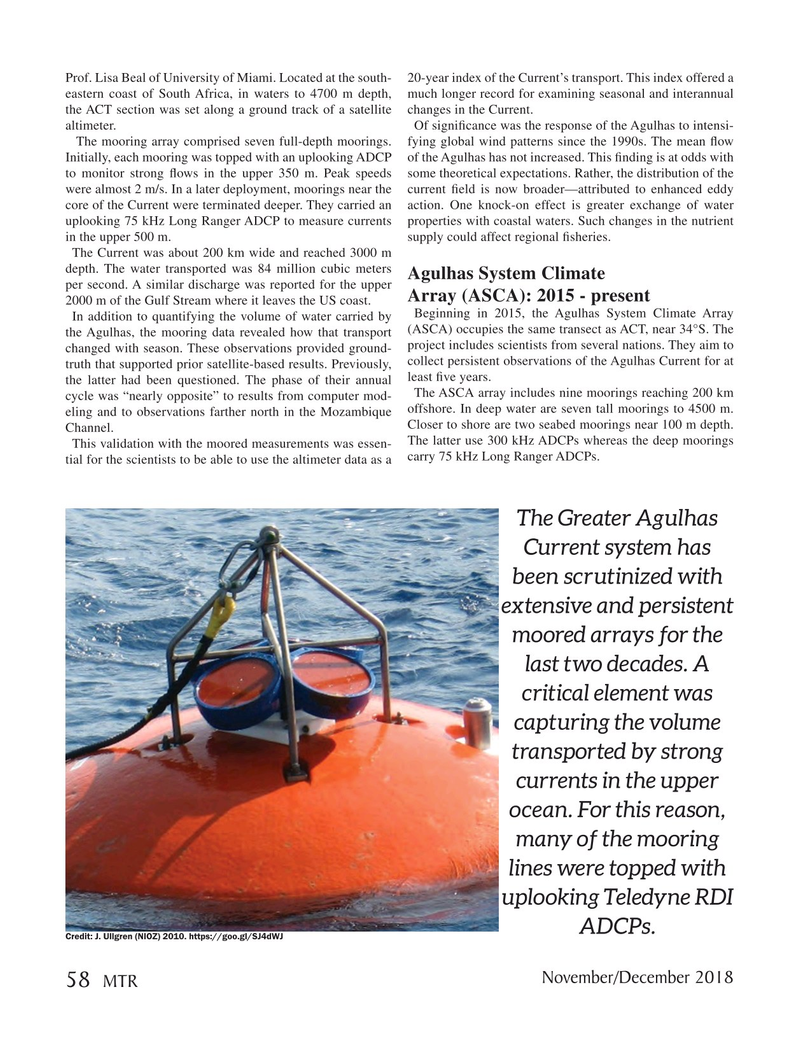
Page 58: of Marine Technology Magazine (November 2018)
Acoustic Doppler Sonar Technologies ADCPs and DVLs
Read this page in Pdf, Flash or Html5 edition of November 2018 Marine Technology Magazine
Prof. Lisa Beal of University of Miami. Located at the south- 20-year index of the Current’s transport. This index offered a eastern coast of South Africa, in waters to 4700 m depth, much longer record for examining seasonal and interannual the ACT section was set along a ground track of a satellite changes in the Current. altimeter. Of signi? cance was the response of the Agulhas to intensi- The mooring array comprised seven full-depth moorings. fying global wind patterns since the 1990s. The mean ? ow
Initially, each mooring was topped with an uplooking ADCP of the Agulhas has not increased. This ? nding is at odds with to monitor strong ? ows in the upper 350 m. Peak speeds some theoretical expectations. Rather, the distribution of the were almost 2 m/s. In a later deployment, moorings near the current ? eld is now broader—attributed to enhanced eddy core of the Current were terminated deeper. They carried an action. One knock-on effect is greater exchange of water uplooking 75 kHz Long Ranger ADCP to measure currents properties with coastal waters. Such changes in the nutrient in the upper 500 m. supply could affect regional ? sheries.
The Current was about 200 km wide and reached 3000 m depth. The water transported was 84 million cubic meters
Agulhas System Climate per second. A similar discharge was reported for the upper
Array (ASCA): 2015 - present 2000 m of the Gulf Stream where it leaves the US coast.
Beginning in 2015, the Agulhas System Climate Array
In addition to quantifying the volume of water carried by the Agulhas, the mooring data revealed how that transport (ASCA) occupies the same transect as ACT, near 34°S. The project includes scientists from several nations. They aim to changed with season. These observations provided ground- truth that supported prior satellite-based results. Previously, collect persistent observations of the Agulhas Current for at the latter had been questioned. The phase of their annual least ? ve years.
The ASCA array includes nine moorings reaching 200 km cycle was “nearly opposite” to results from computer mod- eling and to observations farther north in the Mozambique offshore. In deep water are seven tall moorings to 4500 m.
Closer to shore are two seabed moorings near 100 m depth.
Channel.
The latter use 300 kHz ADCPs whereas the deep moorings
This validation with the moored measurements was essen- tial for the scientists to be able to use the altimeter data as a carry 75 kHz Long Ranger ADCPs.
The Greater Agulhas
Current system has been scrutinized with extensive and persistent moored arrays for the last two decades. A critical element was capturing the volume transported by strong currents in the upper ocean. For this reason, many of the mooring lines were topped with uplooking Teledyne RDI
ADCPs.
Credit: J. Ullgren (NIOZ) 2010. https://goo.gl/SJ4dWJ
November/December 2018 58
MTR
MTR #9 (50-63).indd 58 MTR #9 (50-63).indd 58 11/28/2018 11:01:12 AM11/28/2018 11:01:12 AM

 57
57

 59
59
